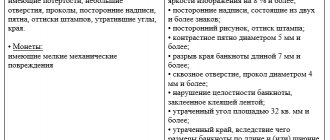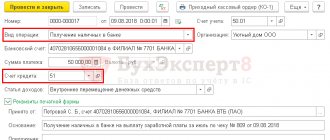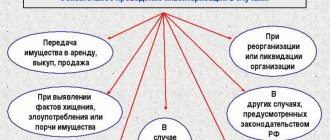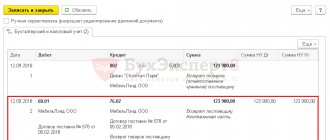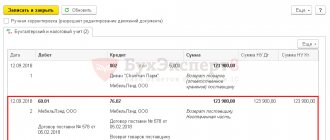Reflection of surpluses discovered as a result of the cash register inventory
Excess cash and other assets identified during the inventory are accepted for accounting. However, they will be taken into account at the current market value, and not at the prices of the previous period. As a result, on the date of discovery of the surplus, its value may be either higher or lower (which happens more often) than its price at the time of its occurrence.
Important!
When taking inventory, the difference between the actual availability and the data indicated in the accounting records must be recorded precisely in the reporting period in which the audit was carried out.
Thus, other income appears in accounting, which must be indicated on the credit of account 91 (Other income and expenses) in subaccount 91-1 (Other income). These operations are shown in the table.
Topic 7 Cash register inventory. Reflection of inventory results in accounting
| Top: Reflection of the acquisition process in the accounting accounts: The procurement process represents a system of economic events, including the acquisition by an organization from suppliers of raw materials... Marxist theory of the origin of the state: According to Marx and Engels, the development of society and the changes occurring in it are based on... Fundamentals of ensuring the uniformity of measurements: Ensuring the uniformity of measurements is the activity of metrological services aimed at achieving... Interesting: Engineering protection of territories, buildings and structures from hazardous geological processes: Studying landslide phenomena, assessing the stability of slopes and designing anti-landslide structures are the most pressing tasks facing domestic... Principles of cash flow management: one of the methods of controlling cash flow is... National wealth of the country and its components: to assess the elements of national wealth... | ⇐ PreviousPage 3 of 3 |
Cash inventory is a check of primary and secondary accounting documentation, the balance of the cash book and cash in the cash register. The entire audit must be carried out taking into account Order No. 49 of the Ministry of Finance of the Russian Federation, letter approved by the Board of Directors of the Central Bank No. 40.
The results of the inventory are considered at a meeting of the inventory commission.
The inventory commission must identify the reasons that determine the need to make clarifying entries in the accounting registers, and propose ways to reflect the inventory results in accounting.
The inventory commission establishes:
1) whether there are persons in the organization who are financially responsible for the safety of valuables, determines the amount of this responsibility;
2) analyzes possible ways to recover doubtful accounts receivable through debt transfer, barter transactions, etc.;
3) a special inventory is drawn up for objects that are not suitable for further operation and cannot be restored, indicating the time of commissioning and the reasons for unsuitability (damage, complete wear), as well as proposals for sources of write-off of these objects;
4) the inventory commission identifies the causes of shortages and surpluses;
5) regarding the occurrence of surpluses or shortages, the commission must receive detailed explanations from financially responsible persons.
The meeting of the inventory commission is documented in a protocol, which records the conclusions, decisions and proposals based on the results of the inspection of the state of the warehouse and ensuring the safety of inventory items.
In addition, the protocol provides information about production inventories that have become unusable, indicating the reasons for the damage and the persons responsible for this.
At a meeting of the inventory commission, the final inventory act is approved.
Discrepancies identified during the inventory between the actual availability of property and accounting data are reflected in the manner prescribed by current regulatory documents.
The results of the inventory must be reflected in the accounting and reporting of the month in which the inventory was completed, and the results of the annual inventory - in the annual accounting report.
The surpluses identified by the commission are reflected in the accounting records as follows:
Dt sch. 50 (corresponding subaccount) - K-t account. 92 - unaccounted funds identified during inventory were capitalized.
When shortages are detected, the following entries are made:
Dt sch. 94 — Set count. 50 (corresponding subaccount) - the shortage of cash in the cash register is reflected and
Dt sch. 73 — Set count. 94 - its amount is attributed to the financially responsible person.
To organize the accounting of funds and documents, an active account 50 “Cash” is provided. This account has three subaccounts: 50/1 “Organizational cash register”, 50/2 “Operating cash register”, 50/3 “Cash documents”.
Strict reporting forms are accounted for in off-balance sheet account 006 “Strict reporting forms”.
By comparing actual and accounting balances, the result of the inventory is revealed: surplus or shortage.
According to the new Chart of Accounts for accounting of financial and economic activities of organizations, approved by Order of the Ministry of Finance of Russia dated October 31, 2000 No. 94n and in accordance with clause 77 of Order of the Ministry of Finance of Russia dated June 28, 2000 No. 60n “On methodological recommendations on the procedure for forming indicators financial statements of the organization”, surplus funds in the cash register identified during inventory are subject to capitalization (accepted for accounting) and are reflected in non-operating income. In accounting, actual surpluses of funds and documents are accounted for by the following entry:
· Debit 50 “Cash” of subaccount 1 “Cash of the organization” or 3 “Cash documents”
· Credit 91 “Other income and expenses” subaccount 1 “Other income”.
If excess strict reporting document forms are identified, they are reflected in the debit of account 006 “Strict reporting forms” in a conditional (nominal) valuation.
If a shortage of funds is detected, entries are made in the debit of account 94 “Shortages and losses from damage to valuables.” For missing funds and documents, the debit of account 94 reflects their actual cost.
For the amount of shortage of funds and documents identified during the inventory, the following entry is made in accounting:
· Debit 94
· Credit 50 Subaccounts 1 or 3.
The amount of missing strict reporting forms is reflected in the credit of account 006 “Strict reporting forms”. If the shortage of funds and documents is due to the fault of the financially responsible person - the cashier, then its amount is written off in the accounting records by posting:
· Debit 73 “Settlements with personnel for other operations” subaccount 2 “Settlements for compensation of material damage”
· Credit 94 “Shortages and losses from damage to valuables.”
Reimbursement of the amount of the shortfall is possible from the cashier’s salary, which is reflected in the following entry:
· Debit 70 “Settlements with personnel for wages”
· Credit to account 73/2 “Calculations for compensation of material damage.”
If the shortage is reimbursed to the organization’s cash desk, then the following entry is made in the accounting records:
· Debit 50/1 "Organization Cash Office"
· Credit 73/2 “Calculations for compensation for material damage.”
In the absence of a specific culprit, the amount of cash shortage, previously reflected in the debit of account 94, is included in the non-operating expenses of the organization and written off by correspondence of the accounts:
· Debit 91/2 “Other expenses”
· Credit account 94
The results of the inventory of cash and documents at the cash desk are documented in the cash inventory act according to form No. INV-15, approved by Resolution of the State Statistics Committee of Russia dated August 18, 1998 No. 8 8, which provides the cashier’s explanations about the identified violations and the manager’s resolution on further decisions on inventory results. The cash register inventory report is drawn up in two copies (if there is a change of cashier - in triplicate), signed by the inventory commission and the financially responsible person and brought to the attention of the head of the organization. One copy of the act is transferred to the accounting department of the organization, and the second remains with the financially responsible person.
⇐ Previous123
Papillary patterns of the fingers are a marker of athletic ability: dermatoglyphic signs are formed at 3-5 months of pregnancy and do not change throughout life...
Individual and group automatic drinking bowls: for animals. Schemes and designs...
General conditions for choosing a drainage system: The drainage system is selected depending on the nature of the protected…
Transverse profiles of embankments and coastal strips: In urban areas, bank protection is designed taking into account technical and economic requirements, but special importance is given to aesthetic...
© cyberpedia.su 2021 — Not the author of the materials. The exclusive right is reserved by the author of the text. If you do not want this material to appear on our website, please follow the link: Copyright InfringementHow to write an explanatory note
Within the framework of current legislation, when surpluses are discovered during inventory, the employer is obliged to require an explanatory note from the cashier.
Important!
The employee does not have the right to refuse and must provide the required document within two working days.
The explanatory note is written on a computer or manually on the organization’s official letterhead. The signature and its transcript are written by hand. If a surplus is detected, a work completion report is drawn up, and a note from the responsible employee is attached to it.
The explanatory note contains two sections:
- The factual section describes the events and conditions that led to the situation described in the document. For example, this can be done like this: “Yesterday, March 20, an inventory was taken at the Ulybka cafe. As a result of the inspection, excess funds were discovered in the cash register.”
- The causal section indicates why extra funds appeared in the cash register. There are usually several reasons, and they need to be properly explained in order to reduce the degree of your guilt or future liability.
When writing an explanatory statement, the facts must be clearly indicated, but there is no place for speculation and reasoning in it. The document conveys to management only what the employee knows and has seen—data and facts.
Excess cash deposited into the cash register - posting
In accordance with clause 3.3 of the Regulations, when an organization conducts cash transactions using cash register equipment, upon completion of their implementation, based on the control tape removed from the cash register equipment, a cash receipt order (form 0310001) is issued for the total amount of cash received. Note that based on the cited norm and other provisions of Chapter 3 “Procedure for accepting cash” of the Regulations, we can come to the conclusion that a cash receipt order is applied only when received from a specific depositor.
The use of this document when identifying the fact of excess funds in the cash register is not provided.
Accounting for shortages in the cash register identified during the inventory of cash - postings, documents
Such an event also often helps to identify cash shortages.
We come to a similar conclusion with regard to the procedure for applying the cash expense order (form 0310002) (clauses 4.1, 4.2 of the Regulations). In other words, when it is revealed that there is a surplus (shortage) of funds at the organization’s cash desk, incoming (outgoing) cash orders are not issued.
Unscheduled audits are carried out in relation to the cash register of an enterprise for the following possible reasons:
- The materially responsible entity has changed.
- The owner of a business entity has changed.
- The presence of reasonable suspicions about the possible theft of the organization’s assets.
- An emergency, a natural disaster, has occurred.
If the employer has initiated another check of the cash register and established the fact of a shortage of cash, he should implement a number of specific measures on this basis.
First, you need to obtain appropriate explanations from the authorized cashier. To provide management with the necessary explanations regarding the detected shortage, the employee in charge of the cash register has only two days. The employer has the right to formulate this requirement by oral order or written document.
Possible reasons for the detected money
The discovery of excess cash in an organization's cash register is often perceived ambiguously by the employer.
This makes management's reaction to the facts of cash surpluses significantly different from the typical consequences of identifying cash shortages, in which embezzlement/theft usually becomes the priority version.
Thus, the presence of excess, unaccounted cash in the cash register can be caused, for example, by the sale of goods at an erroneously indicated (inflated) price or, alternatively, underweight.
Although, of course, such situations rarely arise by chance with modern control and transaction systems.
Speaking about possible reasons, we cannot exclude the fact that cashiers of trade organizations sometimes report their own money to the cash register.
This is often done when there is a shortage of change bills in order to freely give change to customers.
Sometimes employees forget about this, which causes excess cash to appear in the cash drawer.
One way or another, these facts can be regarded as violations of cash discipline, which is not acceptable from the point of view of conducting cash transactions.
Determining the culprit
In order to find out the reasons for the situation and correctly record cash surpluses in accounting, the inventory commission sends appropriate requests to financially responsible entities - the organization's cashiers.
Employees of the company who are personally responsible for the correct management of the cash register provide written explanations regarding excess cash.
Explanatory notes from responsible persons make it possible to identify the entities responsible for the appearance of cash surpluses.
In addition, the solution of this problem is effectively facilitated by reconciling factual information with accounting information.
How is an explanatory note drawn up by the cashier of an organization?
If an audit reveals a cash surplus at an enterprise, the responsible cashier is obliged to provide his employer with an explanatory note regarding this fact.
Current legislation provides that the head of a business entity must require the cashier to provide the necessary explanations in writing within 2 (two) days.
Being a financially responsible entity, the cashier does not have the right to refuse to write an explanatory note.
This paper is an official document.
It can be compiled manually or as a computer printout. One way or another, the explanatory note is written on the official form (form) of the business entity and signed by the cashier (with a transcript).
The explanatory document drawn up by the cashier regarding the detected excess cash contains two key sections:
- Description of facts/circumstances. The prerequisites for the situation that arose or the real events that led to its occurrence are indicated.
- A statement of specific reasons for the appearance of excess (unaccounted for) cash in the cash register. As a rule, there are several such reasons. They should be correctly identified to minimize the degree of guilt and mitigate future liability.
In addition, the explanatory paper, presented in two copies, must contain the following mandatory details:
- name of the business entity (employing company);
- Full name, position of the manager;
- the name of the paper itself (“Explanatory”);
- Full name, position of the responsible employee (cashier);
- date of preparation of the document, signature of the originator.
When the document is fully drawn up and signed by the cashier, it should be provided to the employer. The manager signs the paper (both copies) with the registration number. One copy must remain with the compiler (cashier).
What documents need to be completed?
The work of the inventory commission to identify and investigate cash irregularities in the organization is necessarily recorded by maintaining a special protocol, which reflects the following:
- detailing the results of the cash audit;
- description of methods used to identify cash surpluses;
- expert conclusions regarding the discovery of excess cash in the company's cash register.
The results of the activities of the inventory commission in the prescribed form are provided to the head of the organization, who authorizes the acceptance of excess cash into the cash desk by issuing a special administrative act.
The documentary basis for drawing up such an order is the cash inventory report, drawn up by the audit commission according to the INV-15 standard and containing the following information:
- basic details of the company;
- number and date of the inventory order (documentary basis for verification);
- number and date of formation of the INV-15 act;
- date of execution of the cash audit regulated by management order;
- financially responsible entity (full name, position) with signature;
- detailing of factual information and accounting data on the state of cash;
- determination of the total - the amount of the detected surplus;
- numbers of the latest cash orders (receipt / expense);
- Full name, position, signatures of all commission members;
- confirmation by the cashier of responsibility for the available cash in the cash register;
- the reason for the detected excess;
- signature of the financially responsible entity (with transcript);
- the manager's verdict regarding the discovered surplus;
- signature of the manager (with transcript and date).
Cash surpluses identified during inventory
Sometimes excess cash is found in the cash register of a business entity. As in the case of shortages, the fact of identifying an excess amount of cash requires documentation, accounting, and an adequate response from management.
After all, the execution of all cash transactions of an enterprise is within the competence of the cashier - an employee with whom the employer enters into an agreement on full financial responsibility.
| The article describes typical situations. To solve your problem , write to our consultant or call for free: +7 (499) 490-27-62 - Moscow - CALL +7 (812) 603-45-17 - St. Petersburg - CALL +8 ext.849 - Other regions — CALL It's fast and free! |
Accordingly, cash accounting is an important aspect of the economic activity of an organization.
Strict adherence to its rules and regulations is key to the smooth running of the company.
Possible reasons for the detected money
The discovery of excess cash in an organization's cash register is often perceived ambiguously by the employer.
This makes management's reaction to the facts of cash surpluses significantly different from the typical consequences of identifying cash shortages, in which embezzlement/theft usually becomes the priority version.
Thus, the presence of excess, unaccounted cash in the cash register can be caused, for example, by the sale of goods at an erroneously indicated (inflated) price or, alternatively, underweight.
Although, of course, such situations rarely arise by chance with modern control and transaction systems.
Speaking about possible reasons, we cannot exclude the fact that cashiers of trade organizations sometimes report their own money to the cash register.
This is often done when there is a shortage of change bills in order to freely give change to customers.
Sometimes employees forget about this, which causes excess cash to appear in the cash drawer.
One way or another, these facts can be regarded as violations of cash discipline, which is not acceptable from the point of view of conducting cash transactions.
Carrying out an inventory
The norms of Russian legislation provide for the mandatory carrying out of inventories by legal entities. Entrepreneurs are exempt from such audits.
The basis for starting to check the compliance of actual inventories with accounting information is an order from the head of the enterprise conducting the reconciliation. This order specifies:
- the composition of the commission by name;
- inventory object;
- reconciliation period.
The absence of one of the required information may be grounds for invalidating the order.
The Ministry of Finance of the Russian Federation, in paragraph 2.3 of the Methodological Instructions put into effect by Order No. 49 of June 13, 1995, especially emphasized that all members of the commission, without exception, participate in the inventory. Failure to comply with this instruction leads to the recognition of the reconciliation as failed.
Cash audit rules
The cash register inventory is carried out at a frequency established by order of management and enshrined in the accounting policy of the enterprise. The same regulations establish the inventory procedure. The cashier is recognized as the financially responsible person for the cash register.
Before the inventory, the manager (director) issues an order (order), which indicates the start date and composition of the inspection commission.
The commission must include at least three people. The presence of the MOL on the commission's list is mandatory. In addition, the presence of security and internal audit employees (if available) is desirable. If there is no signature of even one of the commission members, the inventory is considered invalid.
Before checking, the cashier stops all operations and generates a cash report.
Example of a cash report
This report reflects all incoming and outgoing orders, which, in addition, must comply with the approved forms. Identified missing or excess amounts are reflected in accounting during the audit period.
During the inventory the following is also checked:
Get 267 video lessons on 1C for free:
- Free video tutorial on 1C Accounting 8.3 and 8.2;
- Tutorial on the new version of 1C ZUP 3.0;
- Good course on 1C Trade Management 11.
- Setting a limit on the balance of DS at the cash desk;
- Inconsistency between the dates of cash receipts and the actual issuance of money;
- Correctness of correspondence of cash document accounts;
- Whether unpaid wages were deposited on time.
Based on the results of the inventory, an inventory report INV-15 is drawn up. In commercial organizations, surpluses and shortages are written off to the financial result.
Example of an inventory report
Unscheduled audit of the cash register
The cash register inventory can be carried out unscheduled, suddenly and without warning, in order to control the responsibility of the MOL. The timing and procedure for unscheduled inventory are also established by the regulations of the enterprise.
Inventory: accounting entries
If surpluses are identified during inventory, the following entries are generated:
If, for example, a surplus is detected at the cash register, the posting will be as follows:
Debit account 50 “Cash” - Credit account 91-1
Thus, if surpluses are identified, the posting is constructed as a debit to the property accounting accounts in which it is recorded, and a credit to account 91-1.
Accounting entries for inventory in the event of shortages:
| Operation | Account debit | Account credit |
| A shortage of materials was identified as a result of an inventory count. | 94 “Shortages and losses from damage to valuables” | 10 "Materials" |
| The inventory revealed a shortage of fixed assets | 01 "Fixed assets" | |
| A shortage of finished products was identified during inventory | 43 “Finished products” | |
| The shortage was written off within the limits of natural loss | 20 “Main production” 25 “General production expenses” 44 “Sales expenses”, etc. | 94 |
| The shortage of valuables in excess of loss norms was written off in the presence of culprits | 73 “Settlements with personnel for other operations” | |
| The shortage of valuables in excess of the loss norms is written off if the perpetrators are not identified or the court refuses to collect from them | 91-2 “Other expenses” |
The company establishes the cash register inventory procedure independently. But there are cases when cash register inventory is mandatory:
- when transferring property for rent, redemption, sale, as well as during the transformation of a state or municipal unitary enterprise;
- before drawing up annual financial statements (except for property, the inventory of which was carried out no earlier than October 1 of the reporting year);
- when changing financially responsible persons;
- when facts of theft, abuse or damage to property are revealed;
- in the event of a natural disaster, fire or other emergency situations caused by extreme conditions;
- during reorganization or liquidation of the organization.
During the inventory, the presence in the cash register of the values listed in the guidelines for inventory, the regulations on making cash payments and (or) payments using payment cards without the use of cash register equipment, approved. Decree of the Government of the Russian Federation of May 6, 2008 No. 359. These are the following values:
- cash;
- monetary documents (postage stamps, paid vouchers to holiday homes and sanatoriums, air and railway tickets, payment cards for communication services, fuel cards, etc.);
- securities forms;
- strict reporting document forms.
After a complete page-by-page recalculation of cash, the result is checked against the accounting data in the cash book. To reflect the results of the inventory of the actual availability of funds and monetary documents located at the organization's cash desk, a cash inventory report is drawn up (form No. INV-15 can be used).
The actual availability of forms of securities and forms of strict reporting documents is carried out by type of form, taking into account the starting and ending numbers of certain forms, as well as for each storage location and financially responsible persons (clause 3.41 of the Methodological Instructions for Inventory). The results of the inventory of securities forms and strict reporting document forms are reflected in the inventory list of securities and strict reporting document forms (INV-16).
In addition, an inventory is carried out:
- funds in transit;
- funds in the organization's current accounts;
- funds in the organization’s foreign currency accounts;
- funds in special accounts of the organization (except for deposit accounts that are covered by the inventory as financial investments of the organization).
When inventorying funds in transit, the balance in account 57 “Transfers in transit” is compared with the data of receipts from a bank institution, post office, copies of accompanying statements for the delivery of proceeds to bank collectors, etc. (clause 3.42 of the Methodological Instructions for Inventory, Instructions for the use of the Chart of Accounts).
An inventory of funds held in banks in settlement (current), currency and special accounts is carried out by reconciling the balances of accounts 51 “Currency accounts”, 52 “Currency accounts”, 55 “Special accounts in banks” (except for subaccount 55-3 “ Deposit accounts") according to accounting data with data from bank statements.
Let's consider how to reflect the results shown by the cash register inventory.
What to do if excess funds are identified during inventory?
Cash surplus means that the real amount of available cash of the enterprise, confirmed by the results of the audit performed, exceeds the amount of cash recorded in the cash accounting registers.
Excess cash in a company is often detected by the inventory commission based on the results of a cash audit.
When such facts are discovered, members of the commission carrying out the inventory of the cash register study the accounting documentation.
The commission’s tasks are to document this fact, establish the causes of the cash surplus, determine the culprit of the detected violations, and correctly eliminate the identified discrepancies in accounting.
What to do if there is a surplus at the cash register
Cash documents are drawn up in the same way as cash in the organization's cash register using cash receipts and cash outflow orders, on the basis of which a report on the movement of cash documents is compiled. This report indicates how many and what kind of monetary documents were received, their value, as well as which monetary documents were issued and to whom and for what amount. The information from the compiled report on the posting and issuance of monetary documents is used for analytical accounting, the registers of which can be a book of accounting for the movement of monetary documents by their individual types. The separation of this part of cash transactions into a separate sub-account is due to the diverse composition of monetary documents and their assessment based on the amount of actual acquisition costs.
Table 3
Typical accounting entries for account 50 “Cash”
| No. | Contents of a business transaction | Debit | Credit |
| Cash was transferred from the operating cash desk to the main cash desk of the organization | 50-1 | ||
| Cash foreign currency withdrawn from a foreign currency account was credited to the cash register | |||
| Cash overpaid to the supplier was credited to the cash register | |||
| Cash previously issued to the supplier as an advance for the upcoming delivery of material assets (work, services) has been credited to the cash register. | |||
| Cash received under credit and loan agreements was entered into the cash register | 66,67 | ||
| Unused cash previously issued on account was returned to the cash desk | |||
| Cash received from an employee to compensate for material damage was entered into the cash register. | |||
| Received cash for goods (work, services) sold in retail trade and service organizations | |||
| Cash received from the sale of other property of the organization, as well as operating and non-operating income | |||
| Cash received free of charge was capitalized | |||
| Excess cash identified during inventory was capitalized | |||
| A loan was provided to another organization in cash | |||
| Cash paid in excess by the buyer (customer) has been returned | |||
| Cash issued on account | |||
| Dividends (income) were paid from the cash register to the founder (participant) of the organization, who is not an employee of the organization | |||
| Deposited wages were paid to employees from the cash register | |||
| Cash and monetary documents lost due to emergency circumstances are written off as losses | |||
| Cash handed over to the collector |
The cash register and cash transactions must be checked at least once a month. If a shortage is detected during check of the cash register, it can be written off in two ways:
1. If the cashier is at fault, then the shortage of money in the cash register is reimbursed at his expense. In this case, the following records are compiled:
| Debit | Credit | Decoding |
| Writing off shortages from the cash register | ||
| The amount of the shortfall is attributed to the guilty party | ||
| The amount of the shortfall is withheld from wages |
2. If the guilty person is not found, then the amount of the shortfall is attributed to the financial result:
| Debit | Credit | Decoding |
| Writing off shortages from the cash register | ||
| The amount of the shortfall is charged to expenses |
If the shortage occurred due to emergency circumstances, it is charged to account 99 “Profits and losses”: D 99 - K 50.
When surpluses are identified, cash is received, and the corresponding amount is credited to the financial results of the organization (Account 91-1 “Other income”): D 50 - K 91.
II. Accounting for cash in the cash register using the example of Prostor LLC.
1 General characteristics of Prostor LLC
Prostor LLC is a commercial organization engaged in the sale of furniture.
Prostor LLC operates on the basis of the Civil Code of the Russian Federation, Federal Law, constituent documents of the company, and current legislation of the Russian Federation.
The Company is a legal entity under the legislation of the Russian Federation and acquires the rights of a legal entity from the moment of its state registration.
The Company bears property liability for its obligations with all its property and acts in relations with third parties on its own behalf.
The company independently carries out its activities, manages the profit received, which remains at its disposal after paying taxes and other obligatory payments.
Prostor LLC independently forms its accounting policy, based on its structure, industry affiliation and other characteristics of its activities for the implementation of accounting. The accounting policy of the organization complies with the regulations of the Russian Federation in the field of accounting and is enshrined in a separate order for the enterprise. The accounting policy of the organization determines and guides the further work of not only the accounting services, but also the entire organization.
The company operates on the basis of the charter, has an independent balance sheet, a current account, a round seal, forms and a stamp with its full corporate name.
The organizational management structure of Prostor LLC is presented in the form of diagram 1.
Scheme 1.
Organizational management structure of Prostor LLC
Director of LLC "..."
| Management service | Employees | Service staff |
| Accounting | Sales Department | |
| Chief Accountant | Commodity expert | Cleaning woman |
| Accountant | Sales consultants | Loaders |
| Cashier |
This control structure is linear. Such structures are characterized by strict centralization of work. On the one hand, this improves the controllability of the entire structure as a whole, reducing the likelihood of theft of inventory items locally, which also plays an important role in the work of trade organizations.
But, on the other hand, it is a deterioration in the flexibility of the entire structure, since in order to resolve even operational issues, coordination with senior management is necessary.
The organizational structure is aimed, first of all, at establishing clear relationships between individual divisions of the organization.
Responsibility for organizing accounting in the organization and compliance with the law when carrying out business operations lies with the head of the organization.
Accounting exercises control over the implementation of business contracts, keeps records and analyzes the movement of goods and funds, settlements with suppliers and customers, calculates and analyzes financial results, draws up accounting reports, balance sheets, maintains analytical accounts, current accounts, pays wages to employees of the organization . The accounting department consists of a chief accountant, to whom an accountant and a cashier report.
The chief accountant monitors the financial flow in the organization, the creation of a financial information system, and the work of the accounting department.
Pages: ← previousnext →
12345See all
Related pages:
Accounting for cash transactions and monetary documents
Coursework >> Accounting and Auditing
… cash from the cash register…………………………………………….9 3 Synthetic accounting of cash transactions and monetary documents …………11 3.1 Cash book and cashier reporting………………… ……………………15 3.2 Cash documents …
Accounting of cash transactions and monetary documents (1)
Abstract >> Accounting and Auditing
... accounting for cash transactions and monetary . ” Relevance of studying the topic: “ Accounting for cash transactions and cash documents” ... and spent cash funds of organizations, numbers are assigned to cash documents , checked ...
Accounting of cash transactions and monetary documents (2)
Coursework >> Accounting and Auditing
... the procedure for ensuring the safety of cash and monetary documents - study the methodology for inventorying cash and monetary documents , reflecting the inventory results in accounting This ...
Accounting for cash and monetary documents (2)
Coursework >> Accounting and Auditing
...), as well as accounting for the return of cash and cash documents for transactions performed. Chapter 1. Accounting for cash transactions and monetary documents . funds ...
Accounting for cash transactions (10)
Coursework >> Accounting and Auditing
... cash registers are drawn up in a number of unified forms of primary documents for recording cash transactions: “Receipt cash ...
I want more similar works...
Posting surplus
Unlike a shortage, where suspicions of theft or embezzlement immediately arise, a case of a surplus can have two interpretations. If there is unaccounted money in the cash register, then perhaps some product was sold at an incorrectly indicated price or there was an underweight. In principle, with modern systems of fixation and operations, such cases should not occur by chance.
It often happens that cashiers in small stores, in the absence of a sufficient number of necessary change notes, report them to the cash register from their wallet. Later, due to forgetfulness or busyness, you may not remove the change notes in time, which will lead to the appearance of surpluses and subsequent problems when they are detected.
A shortage was detected at the cash register: postings.
How to reflect surpluses and shortages
The cashier bears financial responsibility for the preservation of monetary documents. The procedure is regulated by the “Procedure for maintaining a cash register No. 40”, approved by the Board of Directors of the Central Bank of the Russian Federation, and Letter of the Central Bank No. 18 dated October 4, 1993. The timing of the inspection at the enterprise is established by the head and enshrined in the order. The inventory is carried out by a specially created commission, which includes representatives of the administration, the chief accountant and the cashier. Before carrying out the procedure, a cash report is drawn up. It includes all primary documents that should be at the cash desk.
If the inventory reveals unclosed statements (for salary payments), then all unpaid amounts are equated to cash.
The amounts paid are recorded separately in the document. The cashier is required to provide a receipt stating that by the time the inventory begins, payment documents have been submitted to the accounting department, and all cash has been capitalized.
Inventory of cash at the cash desk: the procedure for determining and reflecting in accounting
audit procedures Source and reliability of information Audit evidence can be: Internal (received from an economic entity) External (received from third parties) Mixed (received from an economic entity, but confirmed by third parties) The auditor obtains audit evidence by performing the following substantive procedures: Inspection is examination of records, documents, or tangible assets. Observation is the auditor's monitoring of a process or procedure performed by others. Inquiry is the search for information from knowledgeable persons within or outside the entity being audited. Confirmation is the response to a request for information contained in the accounting records. Restatement is checking the accuracy of arithmetic calculations in primary documents and accounting records
Accounting and posting - postings
A copy of the INV-15 act is sent to the accounting department to perform the necessary accounting actions. The accountant makes the necessary postings (account correspondence).
Cash surpluses are recorded by accounting in the month of completion of the relevant check and, if an inventory was carried out, are accounted for on the date of acceptance of the detected cash.
If an annual audit was carried out, its results are reflected in the annual reports.
Identified excess cash in the cash register is reflected in accounting entries using the following entries:
The cash register was robbed
Here's an unpleasant situation: the company's cash register was robbed. Of course, the incident must be reported to the police without delay. But before you do this, take an inventory of your cash and draw up an act - using the standard form No. INV-15. After all, in order to report missing money, you first need to find out how much was actually stolen.
On the day you issue the deed, make the following entry:
DEBIT 94 CREDIT 50
— reflects the shortage of cash that arose as a result of the robbery of the cash register.
Is it necessary to make an entry in the cash book about what happened? Not at all. Just at the end of the working day, when you recorded the loss, show the conditional balance. The one that would have been obtained without subtracting the stolen amount. At the beginning of the next day, reflect the real amount in the cash register.
Simply put, the fact of the gap between the balances at the end of one day and the beginning of another day does not need to be shown in the cash book. But please attach documents confirming the reason for this discrepancy. For example, a cash audit report, documents from the police, explanatory notes from employees and other papers about the theft.
Depending on whether the culprits are found or not, you will record the money that disappeared from the cash register in one way or another in your accounting records.
The culprit could not be found
Unfortunately, criminal cases are often suspended. Simply put, the police never find the robbers. If you have just such a case, then in accounting, classify the missing amounts as other expenses, and in tax accounting - as non-operating expenses (subclause 5, clause 2, article 265 of the Tax Code of the Russian Federation). Show the expenses as of the date when the investigator suspends the case, that is, makes a corresponding decision. Make the wiring like this:
DEBIT 91 subaccount “Other expenses” CREDIT 94
— other expenses are recognized in the amount of the shortfall.
Police found the robber
Have the police found out who is to blame? Then take the shortage to the robber - after all, he will have to reimburse you for the stolen amount. Make the following entry:
DEBIT 76 subaccount “Calculations for compensation of material damage” CREDIT 94
— the amount of money stolen from the cash register was attributed to the culprit.
When calculating income tax, proceed in the same way as for a regular shortfall collected from the cashier. That is, put the same amount into income and expenses.
During the operation of an enterprise, shortages or surpluses of inventory and materials are often identified. What inventory entries should the accountant make in case of discrepancies? We will consider further what documents correctly reflect this procedure.

